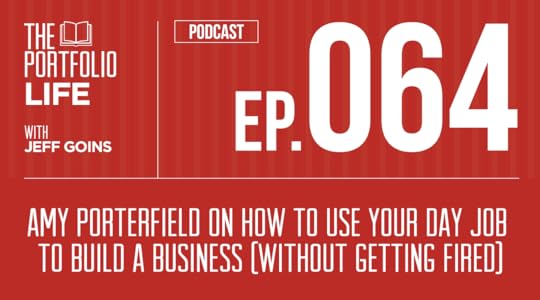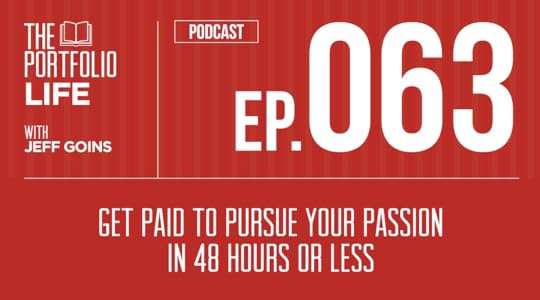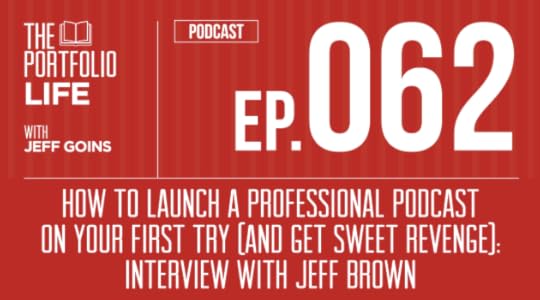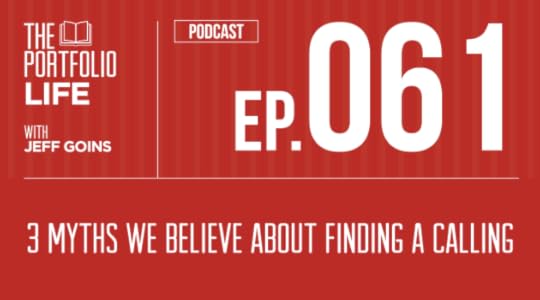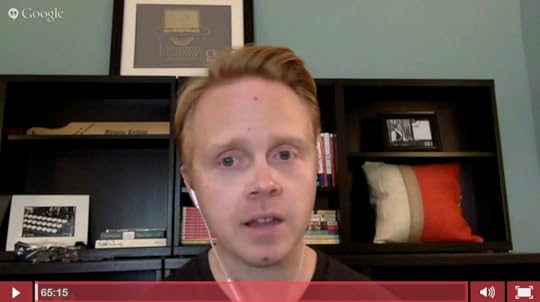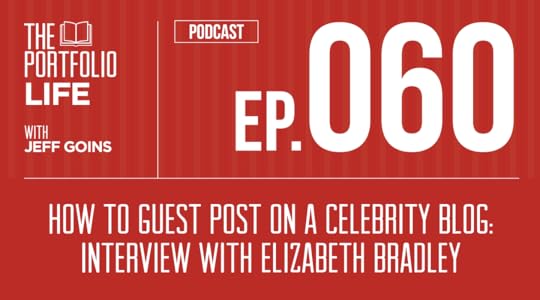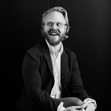Jeff Goins's Blog, page 52
July 16, 2015
064: Amy Porterfield on How to Use Your Day Job to Build a Business (Without Getting Fired) [Podcast]
Hamsters are the spirit animal of most entrepreneurs. They spin their wheels, trying to hustle, but never seem to make any progress. They end up burned out. But here’s the truth: pursuing a passion requires more than hustle.
“Hustle” is one of those trendy terms used as a rallying cry to work hard on a dream and make it happen — as if we can summon a dream into reality by mere blood, sweat, and tears. Although building a business requires elements of hustle, there comes a point when we need to stop hustling.
This week on The Portfolio Life, Amy Porterfield and I talk about her transition from working for Harley Davidson and Tony Robbins to becoming the go-to guru for all things Facebook and what’s next for her.
Listen in as Amy shares her journey from corporate content developer to full-time entrepreneur and online marketing expert.
Listen to the podcast
To listen to the show, click the player below (If you are reading this via email, please click here).
You can also listen via iTunes or on Stitcher.
Pack a parachute while you pivot
Too many people are inspired to chase a dream and decide to quit their job with zero preparation. Taking this leap into entrepreneurship before preparing financially and emotionally is like jumping out of a plane without a parachute.
I made this mistake when I quit my job to become a full-time writer. I prepared financially for the transition, but failed to recognize the emotional implications. I got depressed because I was used to working hard around the clock and didn’t know how to spend the extra time. I needed to discover a new rhythm.
One of the things I found most interesting about Amy’s journey was her preparedness. Instead of blindly stepping off the cliff into the unknown, she took baby steps and built the foundation of her business one block at a time.
Amy’s “leap” took a full-year, but the lessons she learned during an internal pivot at Tony Robbins provided the perfect parachute.
Show highlights
In this episode, Amy and I discuss:
Why vision is a prerequisite for success
The dangers of a “go big or go home” mentality
Three hurdles Amy overcame to become an entrepreneur
Essential baby steps to accomplishing big dreams
How to build a bridge between day job and dream job
Using your current context as a practice ring to acquire new skills
Getting paid to obtain an education and start your own business
Know when to quit your job and pursue a passion full-time
How to make an internal pivot and get closer to your dream
What it takes to become a Facebook expert
The right way to leverage Facebook to grow your business
Why hustle is bad for building a business
Quotes and Takeaways
“Everybody has something they can eventually turn into something bigger on their own.” –Amy Porterfield (Tweet)
Build a business to fit your life, not become your life
Massive progress doesn’t happen overnight
“If you don’t know what you want, you’ll never get there.” –Amy Porterfield (Tweet)
You can design the life you want to live and the work you want to do
Quit trying to hustle
“Make an impact for those you serve.” —Amy Porterfield (Tweet)
Spend time building a bridge between where you are and where you want to be
Resources
Online Marketing Made Easy (Amy’s podcast)
The Profit Lab
How can you pivot at your current job? What can you learn at work to prepare for a big leap? Share in the comments

July 8, 2015
063: Get Paid to Pursue Your Passion in 48 Hours or Less [Podcast]
When you see other people chasing a dream, it’s natural to think they had it easy from the start. You imagine they were born with a camera, football, or typewriter in their crib. But reality tells us a different story.
Every day, you get in your car and drive to work, school, or a coffee shop without thinking about it. But do you remember the first time you got behind the wheel? The anxiety, the sweaty palms, the whiplash?
Just like no one sits in the driver’s seat for the first time and instantly maneuvers like Dale Earnhardt, no one begins pursuing a passion and becomes a legend out the gate. It takes practice.
This week on The Portfolio Life, Andy and I talk about how easy it is to forget the stress of starting and an experiment I did to launch a new idea in 48 hours. Listen in as we discuss practical steps to take a dream and go pro using the resources you didn’t realize you had.
Listen to the podcast
To listen to the show, click the player below (If you are reading this via email, please click here).
You can also listen via iTunes or on Stitcher.
You can do more than you think is possible
The human condition encourages us to pursue safety. To find security in what we know already works and avoid anything that might embarrass us. Steven Pressfield calls this “Resistance.”
The excitement of an idea is quickly faced with excuses about why it won’t work. We become paralyzed by doubt, afraid to try new things. Resistance stops us from starting.
After hearing my story about quitting my job, writing four books, and becoming an entrepreneur most people say, “It’s great for you, but I could never do that.” The truth is while starting is stressful, it’s not as hard as we make it out to be.
To prove this, a friend challenged me to take an idea and launch it within 48 hours. There were only three rules:
My existing email list and social accounts were off limits.
Someone had to purchase something from me.
The budget was meager ($20).
Keeping to these three rules, I accomplished the goal (while helping my wife potty-train our son). Some readers even joined in and launched their own 48-hour projects. And we all learned the same lesson: Starting, even starting over, is scary. But you can do it.
You think you don’t have the resources, but you’d be amazed at what you can accomplish in a short amount of time.
Show highlights
In this episode, we discuss:
Common excuses people use for waiting
Why pursuing a passion is like potty training a toddler
The step-by-step process I used to launch an experiment
Tips on roasting coffee at home
How to start a new project from scratch
What to do if you have a small budget
Examples of regular people who launched something new in 48 hours and got paid
How chasing a dream affects your friends
The slowest way to add people to your email list that still works
Quotes and Takeaways
Starting is scarier in your head than in reality.
You learn by doing.
Upset the comfortable.
You can stretch yourself without quitting your job or risking bankruptcy.
You can do more than you think. You just need to get started.
You have more resources available to you than you realize.
Resources
Coffee Snobber
The Potty Train Your Passion Challenge
How to Learn a New Skill and Get Paid for it in 48 Hours
Roasty Coffee
List Building Challenge with Bryan Harris
SumoJerky with Noah Kagan
Square
Raleigh Coffee Company
Are you in? What are you going to launch or create in the next 48 hours? Share in the comments

July 7, 2015
The Importance of Changing Mediums: Why We Need More Polymaths in the 21st Century
When Picasso got bored with painting things as they appeared, he began experimenting with colors and shapes — an endeavor he would pursue for the rest of his life.
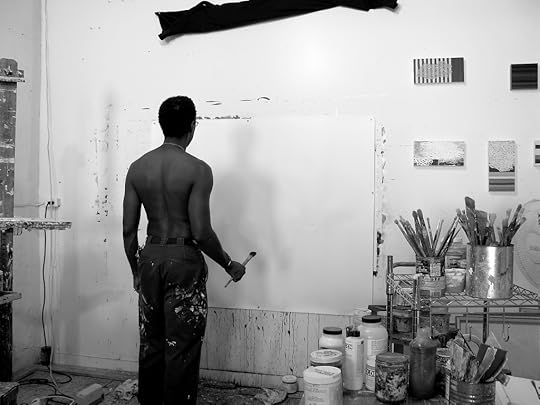
Photo Credit: Tim McFarlane via Compfight cc
My grandfather, the painter, loved Picasso. In his house were abstract oil paintings, attempts at mimicking the master. Because of these paintings, I always assumed Picasso just painted things a little weirdly. But that wasn’t the case at all.By the age of 16, young Pablo had conquered the realist’s palette. Nowhere is this more apparent than in his museum in Barcelona. There, you can see the drawings and paintings a teenager did that look so real you can almost touch them. Leaving that museum, I had a newfound respect for the artist and man.
Picasso learned the rules before he broke them. And as he got older, he needed a more creative challenge. Maybe we all do.
The rise of the new polymath
During the Renaissance, if you had more than one craft, more than one way of doing things, you didn’t have a “bad brand” or ADHD, as we might conclude today. You were a polymath.
Leonard da Vinci was a polymath. A painter, sculptor, architect, and inventor, he was not content to stick to just one craft. In his latter years, he even designed war machines and torture devices for the king of France.
That’s like the Department of Defense calling up Georgia O’Keefe during the Cold War, asking her to consult on developing thermonuclear weapons. It just wouldn’t happen.
Today, we don’t praise what Emilie Wapnick calls multipotentialites. That is, people who have multiple skills they love and may not be comfortable doing only one of them for the rest of their lives (she explains more of this in her excellent TedX talk).
The trick, I think, in doing this effectively is to not try to do everything but to give yourself freedom to focus on more than just one thing. Look at the areas that interest you and find common ground between them.
In other words, don’t be a jack of all trades. Become a master of some.
How the past prepares you for the future
For seven years, I worked a job at a nonprofit that in many ways felt like a distraction from my true calling. I wanted to be a writer but instead spent my days managing people.
I was learning new things like how to use social media and email marketing to tell compelling stories. And I learned how to work with people, motivating them to reach a common goal. I also had to manage a budget and learn how to look at a spreadsheet.
Now, as a full-time writer and business owner, not a day goes by that I don’t use a skill I learned during that seven-year apprenticeship. I wouldn’t have chosen this path, but I can see how everything I’ve done so far has prepared me for where I am today.
And as I’ve grown more comfortable with writing, I’ve started dipping my toe into other mediums, like event planning. It’s a little scary to plan do workshops and large-scale conferences, but I’m excited to learn a new form of artistic expression.
The lesson? Our past can prepare us for our future, if we learn to embrace our present and never stop growing.
The work is never done
After Walt Disney mastered the animated short, he tackled full-length feature films.
When he had sufficiently wowed his audiences with that medium, he began shooting nature films. It wasn’t just the fantasy world that captivated him; it was the natural one. And then, he began the project that would consume him until he died.
When Disney got into the theme park business, he left behind movies almost entirely, letting others manage that side of the business. Occasionally, he would still peek in and see how things were going, but for the most part his focus was on Disneyland.
Now, Walt had what he’d always wanted: a project that would never be finished, something he could always tinker with. For a man who never got to be a boy, this was the ultimate dream — endless play.
The great artists, it seems, get bored with just one medium. They don’t want to be pigeonholed, no matter how successful they became. Just this weekend, I read about Jim Henson, the famous creator of the Muppets, and how he planned to build a series of theme park rides before his untimely death.
It seems we are never done creating, never done working, never done expressing what we have to share with the world.
The problem we face today
Too many writers don’t take the time to understand technology. Too many musicians miss the boat on a basic business education. And too many educators don’t pay attention to what’s going on in the culture outside their institution. In our culture today, we are in desperate need of more polymaths.
We need more renaissance men and women. So where does that leave you? Probably a litte confused. Here’s my advice:
Don’t long for a better life — live the one you have. “Wherever you are,” missionary Jim Elliott once said, “be all there.” Making the most of your current reality is the best practice for what’s to come. I write more about this in The Art of Work.
Don’t get stuck in a single pursuit — create a body of work. Like Picasso, keep looking for other skills and interests you can develop that will complement your core. You never know where a new fascination might lead.
Don’t be afraid to change mediums — keep trying new things. Sometimes, the way we get to our best work is by quitting something else. As evidenced in the life of Walt Disney, there is power in the pivot.
May you embrace multiple mediums and become your own version of a renaissance man or woman. It just might be the most satisfying thing you do.
When was the last time you tried tackling a new medium? Share in the comments.

July 3, 2015
What We Learn About Life from Fairy Tales
At the beginning of every great story, before anything exciting happens, we see something that looks a lot like normal life. Long before the protagonist slays a dragon or the heroine embarks on a quest, we see her in some unsuspecting place, dreaming of something more.

Photo Credit: tbee via Compfight cc
In Beauty and the Beast (my personal favorite Disney classic), Belle sings of wanting more than “this provincial life.” In Star Wars, Luke can’t wait to escape the boredom of a farmer’s life. And in The Wizard of Oz, Dorothy sings about life “somewhere over the rainbow.”
It’s easy to dismiss such people when we meet them in everyday life as dreamers or even downright crazy. But are they really? I used to get up early on Saturday mornings and write essays that I would then save on my computer and share with no one. I dreamed of publishing my stories somewhere, but for years, they never left the comfort of my living room.
I’m not alone in this, this dreaming of another life. This is the preoccupation of George Bailey in It’s a Wonderful Life and the fixation of Walter Mitty. It’s the reason we sometimes daydream or stay up late watching movies. Our lives are haunted by the ghosts of what might have been.
Our lives are haunted by the ghosts of what might have been.Click To Tweet
Here’s the good news, though. This is where a story always starts — with an unrealized dream. A hope deferred. A life un-lived. Before a chain of events sets the hero on a course to his destiny, there is a sense that there should be more to life than this. But hopefully, that’s not where the story ends.
At an important moment, everything begins to make sense. This is what storytellers call the “inciting incident,” the moment when the character’s perspective changes and the tale of an average person living an average life becomes one of mythic proportions.
But something has to happen for any of this to take place: The character must choose to enter the story. Belle goes to find her father. Luke leaves home with Obi-Wan. Dorothy gets swept up in a tornado. In any great narrative, there is a moment when a character decides to be more than a bystander. That’s really when a story begins — with the decision to act.
This choice, though, is often preceded by a feeling of discontent. Which is why when people are called to some great task, they know it. They recognize the prompting to do something significant, something bigger than themselves, and then respond.
Why? Because they have been waiting for it their whole lives.
Frustration prepares you for your purpose
My friend Ben Arment says every dream begins with frustration, and I think that’s true. But that frustration must be funneled into awareness that leads to action; otherwise, it becomes bitterness.
You must be willing to do something, to step out into the unknown and see what happens. Until you make this choice, you’ll continue feeling frustrated, seeing other people succeed and chalking it up to luck or some unfair advantage. You’ll be jealous and critical and wonder, why not me? And in doing this, you will deceive yourself.
Because the truth is some do get lucky, and others have been born into privilege. But what are those things to you? You are still called. Chances come to us all, but only those who are ready recognize them.
Chances come to us all, but only those who are ready recognize them.Click To Tweet
So before you know what your calling is, you must believe you are called to something, even if you don’t know what it is yet. That nagging sense that everything is not as it should be, that you were meant for more than the status quo, is an important clue. And what you do with that is essential to how your story unfolds.
What this means is you don’t need some big plan. You just need to be a little dissatisfied with the way things are, to possess a premonition that something is amiss and you may hold the key to fixing it.
You don’t need some big lucky break or a golden opportunity. You don’t even need to “just know” what you’re supposed to do. You just need the willingness to begin. Only then can you dedicate yourself to the work required of you, and only then will you know what it’s worth.
Without this awareness, you won’t be able to recognize the opportunities that come. And they always come to those with open eyes.
Action is required
So what do this mean practically?
First, you must acknowledge the story that you’re in and recognize that your gift is needed. The world will not be made right until you see things as they really are.
Then, embrace the frustration that you feel and decide to do something about it. Committing to a course of action is essential to getting unstuck.
Finally, you must act, paying attention to the lessons you’ll learn along the way and stay flexible enough to change course as you discover new information.
All of this, of course, is predicated on doing something. Every great story begins with awareness but leads to action. You must enter the tale that is unfolding around you and choose to become a part of it. Otherwise, you’re just another dreamer, staring out into an open field or singing some sad song about a rainbow.
And stories are rarely made by those who only dream.
When was the last time you did something instead of dream about it? What did that reveal to you about the story you’re living? Share in the comments.
Note: This was an excerpt of my latest book, The Art of Work, which is now at the lowest price it’s ever been on Amazon. Check it out!

July 1, 2015
062: How to Launch a Professional Podcast on Your First Try (and Get Sweet Revenge): Interview with Jeff Brown [Podcast]
Your fingers tremble as you grip each hold. Your foot slips, and your heart jumps a little higher. At last, you’re on the edge of conquering the peak. But instead of reaching the summit, the guide tells you, “This mountain isn’t for you. Go back down.”
The death of a dream hurts. You invest your energy in climbing a mountain you thought was yours only to face rejection at the top. But what separates you from the rest of the pack is how you learn from the failure. This applies to blogging, business, and even podcasting.
This week on The Portfolio Life, pro podcaster Jeff Brown and I talk about the trajectory of leaving a stable job to pursue a dream and what it really takes to make it in the world of podcasting.
Listen in as we discuss how Jeff’s background in radio prepared him for his new career, why he is singularly responsible for all of my success (you heard me), and what you need to know if you’re thinking about starting a podcast.
Listen to the podcast
To listen to the show, click the player below (If you’re reading this via email, please click here).
You can also listen via iTunes or on Stitcher.
Building a professional podcast starts with this
No one wakes up one morning and decides to climb Mount Everest, expecting to be home in time for dinner. It requires months of preparation, not to mention years of climbing smaller peaks to build the necessary endurance.
Starting a professional podcast is no different — with the exception that you probably won’t die from exposure or gravity while recording an episode.
One reason many podcasts fail is the host neglects two important tenets of excellence: practice and preparedness. During our conversation, Jeff mentioned he spends more time preparing for a show and practicing the questions than actually interviewing his guest.
I thought that was interesting. If you want to launch a podcast that gets noticed and opens new doors of opportunity, you’ll have to do the same. We become what we practice.
Show highlights
In this episode, Jeff Brown and I discuss:
The trajectory of leaving a day job to pursue full-time entrepreneurship
The long tail of revenge
How to adapt to a changing market and thrive
Key attributes to building a professional podcast
Common podcasting mistakes
How to get started and pick a podcast topic
Selecting the right format
Defining your ideal listener
Tricks to expert interviewing techniques
How to monetize a podcast
Quotes and Takeaways
Failure is sometimes a friend in disguise.
“Approach everything you do with excellence.” —Jeff Brown (Tweet)
Don’t be a jack of all trades, be a master of some.
“Perfection is a moving target that prevents us from launching.” —Jeff Brown (Tweet)
The hidden power of podcasting lies in your audience being able to hear your voice. It garners trust in a way text falls short.
“Filling your head with facts and stories is only part of the equation. You actually have to start putting it into practice.” —Jeff Brown
Avoid awkwardly addressing your audience (and why it works).
Resources
Read to Lead Podcast
Reminder: This is the last week to get your tickets to the Tribe Conference at the early price.
If you launched a podcast what would the topic and format be? Share in the comments

June 28, 2015
Why We Are All Secretly Superheroes
“I’m Superman,” my son said to the man painting our house. “Oh,” the man replied and smiled. “I’m sorry, I did not recognize you.” Aiden nodded, turned around, and “flew” away.
My wife and I chose the name Aiden for our son because of our shared Irish descent and we liked the way it sounded. As a writer and lover of words, I also happened to like the meaning behind it: “light bringer.”
But if you were to ask my three-year-old any day of the week what his name is, he would probably say, “I’m Superman.” Or Batman. Or The Incredible Hulk. Or whatever costume he might be donning that day.
Ashley and I have tried to explain to Aiden (I mean, Superman) the difference between real life and make-believe, but it doesn’t do much good. For him, the line between fantasy and reality is at best blurred, if not non-existent. He believes life is an epic adventure and he possesses some secret power the world needs.
And maybe he’s right.
My question for you today is this: Do you remember what that felt like? When you believed you possessed a purpose that was bigger than your fears? When anything was possible and an adventure awaited you?
When did you stop believing that? When did you settle for the status quo? And when, exactly, did you give up your superpower?
Hiding behind normalcy
If you know the Superman story (and being a comic book nerd, I know it quite well), then you know his alter ego is Clark Kent. You might also know he is an alien from a faraway planet.
What you may have missed is that Superman, unlike other superheroes, did not become special through a freak accident. He was born that way. And when he left his home planet and crash-landed on Earth, he became Clark Kent, the adopted son of a couple of farmers.
In other words, Superman does not hide behind a mask. He hides behind normalcy.
I think many of us do that. We believe we have some special purpose but over time lose sight of it. And we spend most of our lives avoiding what we’re really meant to do, because it just seems too scary. Instead, we assume false identities based on our performance, because that’s safer than being who we really are.
When we do this, we deprive the world of our gift and live through a shadow of our true selves.
How I became a writer
For years, I wanted to write but never called myself a writer. When I finally made the decision to embrace my identity, things began to change – not all at once, but faster than I thought they would.
I started a blog, published a book, and quit my job – all within 18 months.
Some might say it happened quickly, but that’s only what it looked like. The truth is I spent a decade wondering what I was supposed to do with my life. I felt like something was missing but didn’t know what to do about that. Of course, I thought about writing but never committed to it, never actually did it – until eventually, it felt like I could do nothing other.
You might say I was stalling during that season of life, and that’s probably true, but that period of waiting was also a time of preparation. And just like Superman’s childhood was a means of preparing him for the task ahead, we all have seasons of stillness that help us become who we’re meant to be.
What to do with the waiting
The lessons during these times, as frustrating as they can be are:
Remember who you are. Listen to your life, and pay attention to what you hear. Before you can tell your life what you want to do with it, Parker Palmer writes, you must listen to your life telling you who you are.
Use your environment. Accidental apprenticeships are all around you, if you’re willing to embrace your context and make the most of it. Everything you do in life can prepare you for what’s to come.
Press into the pain. Take time to practice, even when it’s hard. The toughest times tend to shape your character the most.
Life for me right now is a little crazy. We’re getting ready to move, have a new niece that will be joining the family any day, and I’m traveling non-stop for speaking.
In fact, later this week, I’ll be sharing the stage with Dr. Oz and Marcus Buckingham (no pressure) at a conference that 15,000 people will be attending.
In the midst of all this, I’m trying to remember that who I am trumps what I do, but the latter should flow from the former – not the other way around.
Other news
The Tribe Conference (an in-person event designed to help you connect your message with an audience) is selling fast. Ticket prices go up on July 6 at 11:59 PM PT, so don’t miss out.
An interview I did for Entrepreneur became their #1 article last week. Read about how to find your purpose here.
My new book, The Art of Work , is now available on Audible. Get it for free when you sign up for a 30-day trial. Click here to get started.
How are you becoming who you’re meant to be, using the season you’re in? Share in the comments.

June 26, 2015
061: 3 Myths We Believe About Finding a Calling [Podcast]
I believe everyone has a calling. But the way you find that calling just might surprise you.
This week on The Portfolio Life, Andy and I talk about the myths we believe about finding your calling. Listen in as we debunk those lies we tend to believe, so that maybe you, too, can take another step closer to your purpose.
Listen to the podcast
To listen to the show, click the player below (If you’re reading this via email, please click here).
You can also listen via iTunes or on Stitcher.
Show highlights
In this episode, Andy and I discuss:
Who stands behind every successful man or woman
How affirmation affects our journey to discovering a calling
The dangers of thinking about calling from a tactical perspective
Why making a living and making a life are different
What we miss by focusing on ourselves
An opportunity that is always available
Quotes and Takeaways
Family is not an obstacle to a calling.
A calling is not a job, but a life you live.
Once you find your calling, the journey is just beginning.
You’re not done learning until you’re dead.
Resources
Art of Work: A Proven Path to Discovering What You Were Meant to Do by Jeff Goins
48 Days to the Work You Love by Dan Miller
What is your calling? What have you learned from the journey so far? Share in the comments

June 22, 2015
The Necessary Habit You Need Before You Can Write a Book
Every day, someone emails me asking a question about getting published. I try my best to point them in the right direction, but often the advice I give isn’t what they want to hear.

Photo Credit: Sarahnaut via Compfight cc
When I was starting out as a writer, this was the last thing I wanted to hear. But it was exactly what I needed. Maybe you do, too.
If you want the world to read your words, you have to do something before you ever dream of getting published. You may have guessed it by now. It’s the very thing we writers struggle with the most: You have to write every day.
You can’t write a book if you aren’t writing. Getting a publisher or cracking the code on self publishing to Amazon isn’t going to change anything if you aren’t already doing the work.
These big breaks won’t make your writing life easier. They’ll make it harder. Getting a publisher, getting a book out there, getting your work noticed — these things create anxiety, not confidence. They put pressure on you, and if you aren’t in the creative habit already, you’re doomed.
So what does this look like? I think forming the creative habit requires three things. As I’ve written before, you need a space, a time, and a goal. But to really succeed, you need three other ingredients, as well:
A reason. Don’t just write as an exercise in vanity. Write with intent, as my friend Marion says. Create something you plan to publish, something that must be said.
A plan. If you don’t block out time to write, it’ll never get done. But you also need a plan for what you’re going to write — an outline. Otherwise, you’ll waste your time thinking about writing but not actually doing it.
A community. Writing, in spite of what we hear, is not a solitary effort. The best creativity often happens in collaboration with others. Without a community, you’ll never do your best work.
Most people miss these things. They say they want to write a book some day. They believe they have something to say — and probably do — but without a regular writing habit, it just won’t matter.
You won’t publish a book if you aren’t writing daily. It’s just that simple. And if you aren’t practicing, what you write won’t be worth reading, anyway.
That’s why I’m such a fan of Author Launch, an online community of writers that encourages you to write that book you’ve always wanted to write. There’s nothing quite like it.
Author Launch is a year-long course that delivers weekly video lessons for 46 weeks straight, teaching you everything you need to know about writing a book — from finding the right voice to outlining your book to launching it to the world.
When you commit to writing every day, amazing things happen. They did for me. After a year of writing every day, here’s what happened to me:
I built a blog with over 50,000 readers.
I got a publishing contract.
I started making money off my writing.
Honestly, I never intended to do any of that, but that’s the power of a habit.
If you find yourself saying, “This year will be different” every year, then maybe it’s time to do something different. I suggest getting a plan, joining a community, and having others hold you accountable to your writing goals.
Author Launch does all of that for you, and for the next few days, you can join with an exclusive discount just for being a reader of my blog.
Learn More About Author Launch
Have you ever thought of writing a book? Share in the comments.

June 18, 2015
What I Learned from Not Hitting the New York Times Best Sellers List
The other day, my friend Darrell asked me on a webinar in front of hundreds of people how it felt to not hit The New York Times Best Sellers list with my latest book. I said, “Well, not good. But thanks for reminding me.”

Photo Credit: Kevin Prichard Photography via Compfight cc
Anyone who’s paid attention to my recent launch knows I set a public goal of hitting that list. It was one of a handful of aspirations I had for the year. And I honestly thought I had it in the bag. I followed the rules: wrote the goal down, pictured it in my mind, and worked like mad to make it happen.
Then, it didn’t.
In spite of all my wishing and work, the dream just didn’t come true. That kind of disappointment is hard. But what I learned from the experience was invaluable.
When I launched The Art of Work in March, I ended selling more copies than planned. The book did about 15,000 preorders instead of the anticipated 10,000 (which some say is the magic number you need to hit the list, but nobody knows for sure). For some reason, though, the book didn’t make the NYT list.
It hit USA Today, Publisher’s weekly (two weeks in a row), and the Washington Post best sellers list. But no New York Times. Why not?
How best sellers lists work
First, it’s helpful to understand how these lists work. Most people have no idea. I certainly didn’t — until I began researching this subject. The best overview of the different lists and how they work can be found on Tim Ferriss’s blog.
Suffice it to say, they’re all different but have some similarities, and landing a spot on any one of them is difficult.
Here are some things you may not have known about the best sellers lists:
There’s more than one best sellers list (The New York Times currently has over 30 different lists based on genre).
Every list has their own criteria for what qualifies as a “best seller” (surprisingly, it’s usually not just how many books you sell).
USA Today is the only list that calculates the rank of a book solely by sales figures. They also only have one list, which, some say, makes it a more objective list.
The Wall Street Journal list is made up of mostly business hardcover and non-fiction books. You can sell a ton of books and not hit that list if it’s not the right genre or format.
Some stores don’t report to Nielsen Bookscan, which accounts for roughly 75% of total book sales. In other words, the best sellers lists aren’t looking at all book sales.
Best sellers lists are calculated weekly, so if a book sells a lot in its lifetime but never has a strong sales week, it won’t become a best seller.
There’s no magic number. If reported sales are low one week, you could hit the list with a few thousand sales. Another week, you might miss it with over 10,000 sales. It’s all relative.
Some retailers, like airports, delay their reporting for weeks or even months, which can skew the results and dilute sales numbers.
All preorders count towards the first week of sales. However, if the book ships early, sales numbers can be spread out over a couple of weeks and dilute the book’s rank on a best sellers list.
The New York Times does not disclose all factors they consider in determining whether or not a book will hit the list. So it’s impossible to predict or plan. You can sell just as many, or more, books as someone who makes the list and not know why they didn’t pick you.
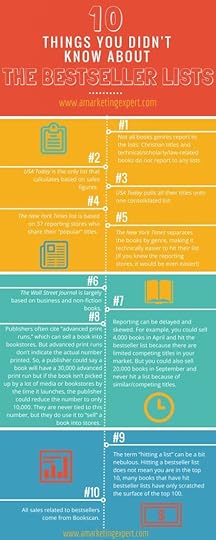
What’s broken about this system is that most people don’t understand what it means to be a “best seller.” Even the lists themselves don’t seem to understand that, since it’s not just a certain number of sales that lands you on one of these lists.
Yes, the best sellers lists are biased and basically a popularity contest. Then again, that’s their prerogative. The New York Times Best Sellers list, after all, belongs to The New York Times. So they can do whatever they want.
Nonetheless, this can be frustrating for writers who try to play by the rules and still don’t make it on a best sellers list. Perhaps the solution, then, is to not play the game in the first place.
To read more about this, check out “The NYT and WSJ Best Seller Lists Must Die.”
What I learned from not hitting the list
Was I disappointed my book didn’t hit the NYT list? Of course. That’s a huge accomplishment and I don’t disparage any author who’s done it. It’s hard. But after the initial disappointment, I dug deep and asked myself what I could learn from this. Here’s what I came up with:
It’s better to attempt great things and fail than to never attempt them at all. Given the choice between trying and failing and not trying at all, I’ll choose something brave and try every time. I’d rather fail at something audacious than succeed at something safe.
If you only set goals you know you can achieve, you’re not dreaming big enough. We’re not promised success in everything we attempt, but we can keep setting goals that are just a few steps away from delusion (for more on that, listen to this goal-setting interview I did with Michael Hyatt).
Don’t measure your success by someone else’s standard. Measure it by your effort. In retrospect, I should’ve set a goal of total book sales (which is more in my control than what the NY Times decides to do). Giving someone else the key to your success is a sure-fire recipe for disappointment.
No matter what, be grateful. After my book launch, I kept complaining to friends about how I didn’t hit the list. And you know what? None of them really cared. When they heard how I sold 15,000 books, they would say, “Dude! Congrats! That’s amazing!” It took some time, but I finally started agreeing.
The next time you attempt something audacious, I hope you’ll learn from my biggest mistake, which wasn’t trying to hit The New York Times list. It was forgetting to celebrate what I did achieve. That’s the trouble with large goals: they can sometimes blind you from what you’ve already done.
In your quest to do something big, don’t miss the joy that comes with the attempt. It’s really the most fun part: the journey, not the destination. As for me, I’ll keep chasing audacious dreams, because I don’t much care for the alternative: settling for the safety of the status quo.
And if that means I occasionally have to face disappointment, then so be it.
If you want to hear more about book launches, failure, and what I’ve learned from the past four years of trying things that didn’t always work, watch this video.
When was the last time you failed at something big? What did you learn? Share in the comments.

June 17, 2015
060: How to Guest Post on a Celebrity Blog: Interview with Elizabeth Bradley [Podcast]
Celebrities who blog enjoy the perks of their fame. Thousands of people care about what they have to say. Landing a guest post on a celebrity blog and leveraging their audience for your platform is easier than you think.
A common misconception about celebrity blogs is they are difficult to guest post on. However, if you position yourself correctly and take your writing seriously, anyone can do it.
This week on The Portfolio Life, Elizabeth Bradley and I talk about her approach to getting featured on Cameron Diaz’s blog, the key components of pitching a post, and why she thinks design is more important than content.
Listen to the podcast
To listen to the show, click the player below (If you’re reading this via email, please click here).
You can also listen via iTunes or on Stitcher.
Position for the perfect pitch
Guest posting is a powerful tool for growing your platform. You develop relationships, increase the visibility of your content, and generate new opportunities.
Some of the biggest names in blogging used guest posting to build their tribe (Brian Clark, Chris Brogan, Leo Babauta to name a few). I used a strategic guest posting approach to gain 10,000 subscribers in 18 months.
It really boils down to positioning a couple elements: you and your content. A celebrity doesn’t know you from Adam. Cameron Diaz knows you from Adam Levine, but that is beside the point.
Positioning yourself communicates to the host blogger who you are in relation to her. Maybe you are a subscriber or maybe you know someone she knows. Establishing the relational connection creates familiarity you can build on.
If a host blogger doesn’t know you, they definitely don’t know what you write about. Positioning your content demonstrates the value you’d bring to the celebrity’s blog in a guest post. Sharing other places you’ve published content strengthens your credibility and shows you take writing seriously. Celebrities are professionals in their craft and appreciate it in others.
Positioning is only half of the process. Waiting for the right opportunity to make the right ask can make a world of difference.
Show highlights
In this episode, Elizabeth and I discuss:
How familiarity with failure leads to familiarity with success
Why rejecting the idea of “finding a niche” provides clarity
The necessary steps to guest post anywhere you want
What one blogger ruined Elizabeth’s guest posting streak
A simple structure for pitching anything to anyone
Myths of guest posting for celebrities
The difference between finding a niche and defining a worldview
Why relationships are critical to spreading a message
A big hurdle to guest posting
The true nature of a tribe
What it takes to get people to help you
Why generosity isn’t enough to build a business
Where the idea of traffic = income is broken
How credibility fits in the equation of increasing authority
Quotes and Takeaways
“Ignore the doubt and failure and do it anyway.” —Elizabeth Bradley (Tweet)
A portfolio life isn’t about doing one thing, but how everything fits together.
Relationships are critical to getting a message to spread.
“If you consistently help people they will help you.” —Elizabeth Bradley (Tweet)
Investing time and money in great design.
Use previous wins to create bigger wins.
Resources
Becoming Holistic: Our Family’s Wellness Journey: Elizabeth’s guest post for Cameron Diaz
How-to: Getting Started with Essential Oils: Casey Wiegand’s guest post for Cameron Diaz
Heart Centered Abundance: Elizabeth’s guest post for Carrie Ann Moss
Elizabeth’s blog: Savouring Simplicity
Elizabeth’s consulting services
Udemy
Tribe Writers
Where do you want to guest post? What are you going to do to make it happen? Share in the comments


